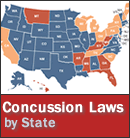Nearly 450 student athletes from Idaho high schools missed practice time or games in the fall of 2012 because of a potential, or confirmed, concussion, reported the Idaho Statesman.
The Idaho High School Activity Association sent surveys to 152 schools to begin collecting data on head injuries among student athletes as a way to track the trend in youth sports, and to determine what training programs are needed for youth sports coaches.

Sixty-eight schools responded to the survey, according to the Statesman, with football and girls’ soccer reporting the most injuries (307 and 72, respectively).
The Idaho survey reveals what many national surveys have already found: that in gender-comparable sports, like soccer, girls experience higher rates of concussions than boys.
The Statesman mentions that there are theories behind the discrepancy, like physiological differences, but Donal Kaehler, the Rocky Mountain High School girls’ soccer coach, thinks it’s more than just head injuries.
Kaehler told the Statesman that it’s more about how boys and girls approach the game.
Concussions and sports-related head injuries among athletes have gotten a lot of attention recently, with multiple studies looking into the long-term effects that these injuries may have on the brain, especially of young athletes.
Despite increased coverage and many states enacting youth-concussion laws, there are still common misconceptions and uninformed behaviors that result in overuse injuries, dehydration, concussions, or worse, according to a report by Safe Kids Worldwide.
For example, 4 in 10 parents underestimate the amount of fluids youth athletes need per hour of play, and 3 in 10 children think good athletes should continue playing, even if they’re hurt, until a coach or another adult tells them to stop, the report said.

Half of the coaches who were surveyed for the report believe there’s an acceptable amount of head contact young athletes can sustain without suffering serious brain injury. What they may not realize, however, is that even a little bit might be too much.
My colleague, Bryan Toporek, has covered the issue extensively on this blog, and two of the notable studies offer an important insight into what changes youth athletics many need to undergo to ensure children and teenagers don’t suffer long-lasting damage from injuries sustained during sports games and practices.
One study published in The Journal of Neuroscience found that concussions can continue to alter a child’s brain even months after the injury was initially sustained, and symptoms are no longer apparent.
More recently, researchers from the University of California, Los Angeles, found a way to identify the signs of chronic traumatic encephalopathy, a degenerative disease, after looking at the brains of five living retired National Football League players.
Diagnosing CTE has been, until now, one of the biggest issues in sports-related concussions, and as Bryan wrote earlier, this ability to diagnose a long-term neurodegenerative disease caused by sports-related concussions couldn’t come soon enough.
Photo: Emergency personnel take New Prairie High School player Tyler Weller off the field after he sustained a concussion during a game against South Bend High School last October in South Bend, Ind. —Bob Wellinski/The LaPorte Herald-Argus/AP-File